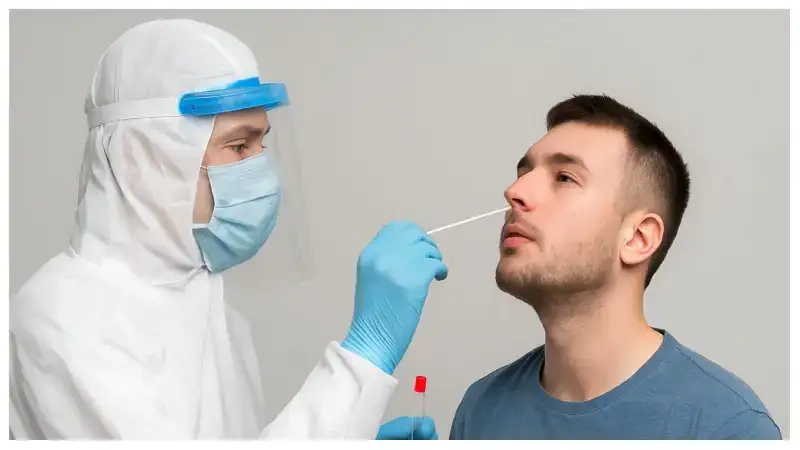Table of Contents
What Causes Brown Specks in Phlegm?
What is Mucus?
Causes of Brown Specks in Phlegm
How to Prevent Brown Specks in Phlegm
When to Seek Medical Attention
FAQs About Brown Specks in Phlegm
Final Thoughts
What Causes Brown Specks in Phlegm?
Seeing flecks of brown in your phlegm can feel unsettling. However, they often come from everyday causes like inhaled dust, smoke tar, or minor bleeding in the airways. By understanding these sources, you can tell the difference between harmless debris and signs of something more serious. For example, experts note that tar and dirt in the respiratory tract are common reasons for brown phlegm. In many cases the brown flecks are harmless, but it helps to know what to watch for.
What is Mucus?
Mucus is a sticky, viscous fluid that lines the nose, throat, and lungs. It’s mostly water plus proteins and antibodies, and it helps trap dust, germs and other particles. When we cough, some of that mucus can come up from the lungs (then called phlegm). Phlegm is essentially mucus produced in the lower airways during inflammation or infection. Healthy mucus (or phlegm) is usually clear or white and helps protect the airways by catching irritants.
What Causes These Flecks?
These flecks often start from inhaled or internal particles. For example, smoking is a major factor: the tar and toxins in cigarette smoke mix into the mucus and give it a brown tint. Many smokers describe how their cough brings up brown spots from tar buildup. Pollutants in the air (like city smog or wood smoke) can also darken mucus. Even tiny amounts of old blood in the lungs will turn brown when it oxidises. In clinical reviews, specialists note that tar, dirt, or even old blood in the airways are common causes of brownish phlegm. Usually these brown specks are minor (dust, dried blood, etc.), but it’s good to pay attention if they keep happening.
Causes of Brown Specks in Phlegm
Common causes of brown sputum include:
Smoking: The tar and chemicals in cigarette smoke accumulate in the lungs, often producing brownish flecks in phlegm.
Air Pollution and Dust: Breathing dirt, smog or smoke (from fires or traffic) can introduce particles that darken the mucus.
Old Blood: Tiny bleeds in the respiratory tract (from a hard cough or throat irritation) produce brown spots as the blood dries and oxidises.
Infections: Severe or chronic infections like bronchitis or pneumonia can cause discoloured phlegm (often brownish) when pus or old blood mixes with mucus.
Occupational Exposures: Jobs involving coal dust, metal fumes, or chemicals may lead to brown specks as irritants are inhaled over time.
In most cases, these causes are benign: the specks are just debris or old blood fragments. But if brown flecks persist or worsen, it’s wise to get checked by a healthcare professional.
How to Prevent Brown Specks in Phlegm
Quit Smoking: Stopping smoking is the single best way to reduce brown specks in phlegm. Over time your lungs clear out accumulated tar.
Avoid Secondhand Smoke: Stay away from cigarette smoke around you. Even indirect smoke can darken your mucus.
Limit Pollutant Exposure: Wear masks or respirators in dusty areas or when air quality is poor. Keep indoor air clean with purifiers or ventilation.
Maintain Airway Hygiene: Stay well-hydrated and practise deep breathing. These help thin mucus and make it easier to clear from the lungs.
Treat Infections Promptly: If you catch a cold or chest infection, get early treatment (fluids, rest, doctor’s care) so blood and pus don’t build up in the lungs.
Manage Acid Reflux: GERD (acid reflux) can irritate the throat and lungs. Following diet and treatment advice from your doctor can minimise mucus discolouration.
Keep Lungs Healthy: A balanced diet, regular exercise, and using humidifiers in dry climates all support lung health and help clear mucus more effectively.
When to Seek Medical Attention
Occasional brown specks in phlegm are usually not alarming, but there are warning signs to watch. If the brown specks persist for days or come with other symptoms, see a doctor. Be especially cautious if you have any of: a persistent or worsening cough, shortness of breath, chest pain, fever, or unexplained weight loss. Also note if you suddenly cough up much more brown or even black mucus or find fresh blood in your sputum. In general, any sudden change in colour, consistency, or amount of phlegm (especially with fever) should prompt medical evaluation.
FAQs About Brown Specks in Phlegm
Why are there brown specks in my phlegm when I cough?
Brown specks can come from harmless sources like dust or tar but also from minor bleeding. Inhaling dirt, pollen or smoke deposits tiny particles that mix with mucus. Smoking (even secondhand) adds tar and resin that colour the sputum. Sometimes coughing hard can break a tiny blood vessel, and that old blood looks brown when it appears in phlegm.
What does brown mucus mean?
Brown mucus usually means contaminants or old blood are present. Common causes include tobacco smoke or environmental dirt mixed in with the mucus. It might also mean an old or healing blood stain from irritation. Less commonly, brownish phlegm can arise during an infection (often yellow/green suggests infection, but brown can appear if there is blood mixed in). Either way, brown sputum indicates that something (smoke, dirt, blood) ended up in the airway.
What is the difference between mucus and phlegm?
Both are fluids from the mucous membranes. Mucus is a protective, slippery fluid made throughout the body (nose, sinuses, throat) to trap dust, pollen and germs. Phlegm is the term for mucus that’s produced specifically in the lower airways (bronchi and lungs), usually in response to infection or irritation. When you cough something up from your lungs, it’s phlegm. Essentially, phlegm is just lung mucus, while “mucus” can refer to similar fluids anywhere in the body.
Is it normal for a smoker to cough up brown mucus?
Yes. In smokers, brown mucus is very common. The brown colour is mainly due to tar, nicotine and other chemicals in tobacco smoke that collect in the lungs. Over time these substances build up and tint the sputum. Smokers with a chronic cough often expect to see a brownish colour in their phlegm. Quitting smoking is the best way to clear this; until then, coughing up brown mucus just means the lungs are trying to expel those irritants.
Is spitting brown phlegm from smoking a sign of cancer?
Coughing up brown phlegm from smoking is not a specific sign of cancer by itself. It is usually the tar and old blood from irritated lungs, as mentioned above. However, long-term smoking does increase cancer risk, so changes in phlegm should be watched. If you notice persistent blood (bright red) or very dark sputum, or if you have other symptoms like weight loss or chest pain, it’s important to get checked.
Are brown spots in your mucus a cause for concern?
Occasional brown spots aren’t necessarily alarming, especially if you know you’ve been exposed to smoke or dust. But if the spots keep appearing, get worse, or come with cough and other symptoms, it’s wise to see a doctor. Persistent brown stains could indicate ongoing irritation, infection or other health issues. When in doubt, it’s best to have a healthcare professional check it so you can rule out any serious causes.
Final Thoughts
Such flecks are often harmless clues about your respiratory environment. They remind us to reduce exposure to irritants (for example, by quitting smoking or wearing masks in dusty areas). Improving lifestyle factors and treating health issues promptly usually leads to clearer, healthier phlegm. If you ever feel uncertain—especially if new symptoms appear—consult a doctor. Staying attentive to changes in phlegm color and texture is a simple way to monitor lung health.


